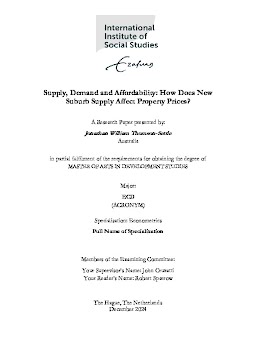2024-12-20
Supply, demand and affordability: How does new suburb supply affect property prices?
Publication
Publication
The affordability of homes in Australia is an increasing problem, creating a growing housing crisis. This problem predominately affects low-income and middle-income households. Australia follows a growing trend of other countries post-1990s, where housing is unaffordable. Even when housing is affordable, it is stretching household budgets, increasing long-term debt and compromising retirement. This paper will discuss the social ramifications of increasing house prices, the policies that support their rise and other demographic trends. The existing economic literature is limited to infill development effects on rent prices in existing neighbourhoods and the mechanisms that create this effect. There are insufficient economic methods within housing economics, mostly focusing on instrumental variables and economic levers (e.g. central bank interest rates). I explore this through my case study of Canberra, Australia. This paper applies a difference-in-difference method to understand greenfield developments. This method has never been before in new suburb supply. The method is applied to surrounding suburbs. The results are inconclusive and cannot suggest any causal effects on property prices. Australian governments at all levels are heavily investing in new supply with little idea of how new supply affects property prices. This paper seeks to address this limited understanding. While this paper claims no causality due to a new method applied to a new topic, the paper represents the first economic exploration of new suburb supply.
| Additional Metadata | |
|---|---|
| , , | |
| Cruzatti Constantine, John | |
| hdl.handle.net/2105/75641 | |
| Economics of Development (ECD) | |
| Organisation | International Institute of Social Studies |
|
Thomson-Settle, Jonathan William. (2024, December 20). Supply, demand and affordability: How does new suburb supply affect property prices?. Economics of Development (ECD). Retrieved from http://hdl.handle.net/2105/75641 |
|
